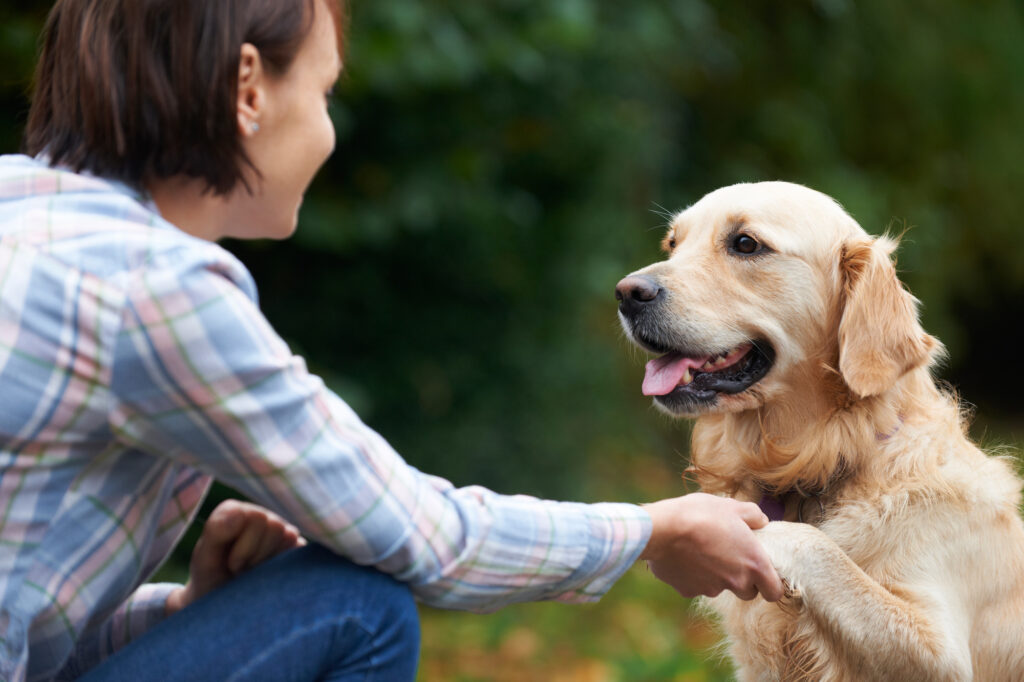Caring for a blind pet is a unique and privileged responsibility. If your pet has become suddenly blind, they may become confused by the sudden nature of its change in vision status. Many pets adapt to their blindness quickly while others need months to adjust to the change.
Vision in cats and dogs is quite different from ours. They have better night vision than we do, but their ability to focus and see fine detail is less developed. In addition, they don’t have well developed color vision. Our pets are less dependent on vision than we are due to their heightened sense of smell and hearing. They utilize these senses very efficiently and loss of vision for dogs and cats is less traumatic compared to vision loss in people. Pets which become blind seem to undergo a 1–3-month period of adaptation, during which time many changes occur. At first they will bump into walls, furniture and doors, but this confusion will improve with time as they adapt.
Over 95% of blind pets readily memorize the layout of their home and yard and can function well with poor or no vision. It does take time for them to learn to get around using their other senses. Most blind pets continue to be happy, but you can help make their life a little easier. Always remember to provide your pet with lots of love and reassurance and continue daily routines.
Here are some guidelines to make life easier for your blind pet:
- Animals adapt to their blindness by memorizing their surroundings. Avoid changing the environment such as moving furniture, pet’s bedding, food and water bowls, and litter boxes. You can consider applying scented oil, like orange extract, to the bottom of the door frame so that your dog can find the door to outside. Placing a bell on the door can also help. If your pet is placed in a new environment, give them time to adjust to the new surroundings. It is also important to use baby gates near stairs to prevent falls. If your pet does fall, try to soothe them and stay calm. It is important to create confidence so that they keep trying.
- If you have a doggie door, your pet may experience frustration finding the way to the door. You can try placing a small mat that has a different texture to it (e.g., straw, Astroturf or stair treads) on each side of the doggie door. Placing a scent unique to that area is also helpful. With your help, your pet will learn that when they’re on the mat, they’re in front of the doggie door. It can also help your pet find its way back into the house from the yard. Placing runners outside of the door leading to the lawn can also help your pet find their way to and from the home.
- One of the most important responsibilities you have to provide is safety for your animal. Be careful of stairways (a textured mat can alert your pet to the tops and bottom of stairwells), open doors, and swimming pools. Pools can be especially dangerous if your pet is allowed outside without supervision. Be sure you have a fenced yard that is safe from harmful objects, plants, and bushes. Placing barriers such as fencing near bushes can prevent eye injuries. Blind cats can easily become confused if allowed to roam outdoors. Consider keeping your cat indoors, or if your cat enjoys time outside, walking them on a leash and harness or using a fenced pen may keep your cat happy.
- Encourage your pet to use its other senses to compensate for the vision loss. Buy noisy toys or toys that have a recognizable odor. There are plenty of toys that crinkle or make sounds to encourage play. Treat dispensing toys are terrific to keep your dog busy. Sniffy mats and puzzles also keep them occupied. These allow your pet to use their sense of smell while playing with the toy. Consider buying a ball that has a bell inside for those pets able to hear. Some people may want to get a companion animal that the blind pet can follow around using their hearing and smell. If you have another pet, it may be a good idea to place a bell on them so that your blind pet can locate them more easily.
- Some behavior changes (aggression, depression) can be observed with sudden blindness. Avoid stressing or scaring blind pets. Instruct family members and friends (especially children) to vocalize the pet’s name and approach them slowly. This fear usually passes with time as the pet learns to adjust to the blindness. To help your pet adapt to greeting strangers, try training your dog to a “cue word” that will alert them that someone is about to touch them. Saying, ‘Touch’ is a good example. Also, announce to your pet that you are going to pick it up before doing so. If your pet is also deaf, tap the floor with your hand or foot to give a signal before touching your pet. It is very important to continue walking and playing with your pet! If your pet won’t walk, carry them outside to a park or patch of grass to let them sniff and enjoy some exploring. Walking, playing ball and car rides, etc., keeps your dog’s mind busy and happy.
- If your pet is blind due to cataracts, it may be a good idea to observe their eyes daily for any changes that could indicate your pet has developed glaucoma or uveitis (intraocular inflammation). These diseases may be painful. Watch for reddening of the white of the eye, increase in size of the eye, pawing or rubbing of the eye, or a change in the position of the cataract. Contact your regular veterinarian or veterinary ophthalmologist if any of these signs occur.
- Also, because your pet is blind, they may bump into something or in some way injure the eye or eyelids. Injuries to the surface of the eye (corneal abrasions) are painful and will often cause excessive tearing, mucous discharge, squinting, and/or rubbing. Again, be sure to take your pet to your veterinarian or veterinary ophthalmologist if you notice these symptoms. It may be a good idea to teach your dog to wear Doggles, RexSpecs, or Optivizor to protect their eyes.
- You can continue to take your blind pet for walks if you make a few minor adjustments. Consider switching from a collar to a harness. A harness may make your pet feel more secure walking at your side. Be as consistent as possible on your walks; always go out the same door and take the same path. If you follow the same route for each walk, your pet will better adapt to their surroundings and be more prepared for steps, curbs, and turns. Consider speaking, whistling, or singing while on a walk. These vocalizations will allow your pet to hear where you are. Place a bell on your ankle so that you dog can know where you are. It may be best not to let your blind pet socialize with other unfamiliar animals while on a walk. Inform other owners who are walking their dogs that your pet is blind and may become defensive or aggressive with unfamiliar dogs. Their dog may also become aggressive and try to take advantage of your blind pet’s disability. If your dog is dog friendly, continue letting them play with their friends.
Blind pets have a good quality of life and make very happy pets. If you make simple adjustment, your pet will become more confident and enjoy their daily life.
For more information, go to the ACVO Vision for Animals Foundation: visonforanimals.org



